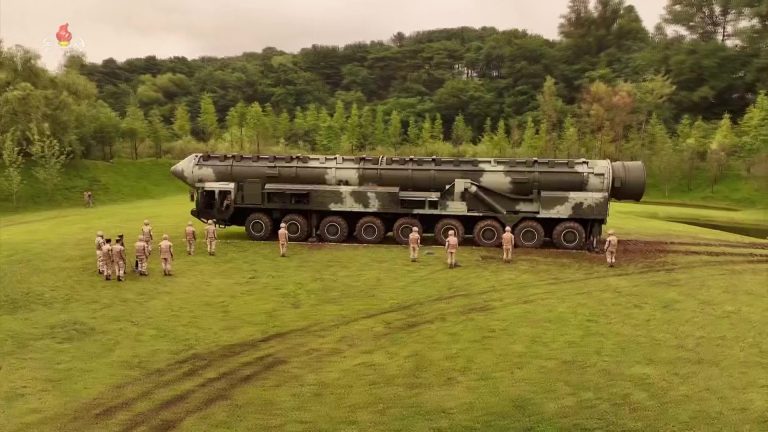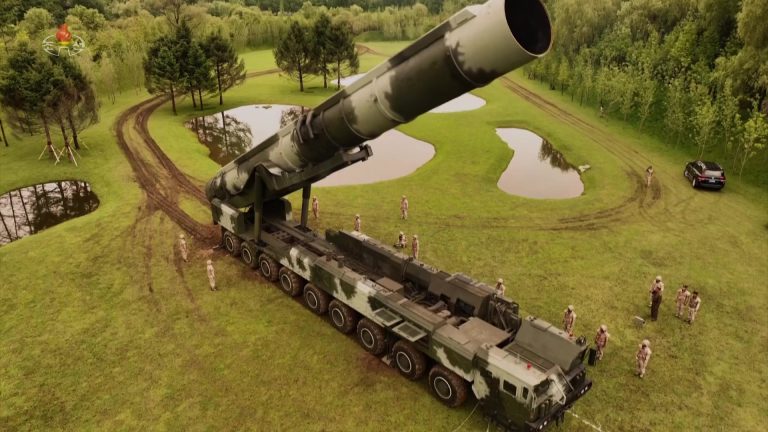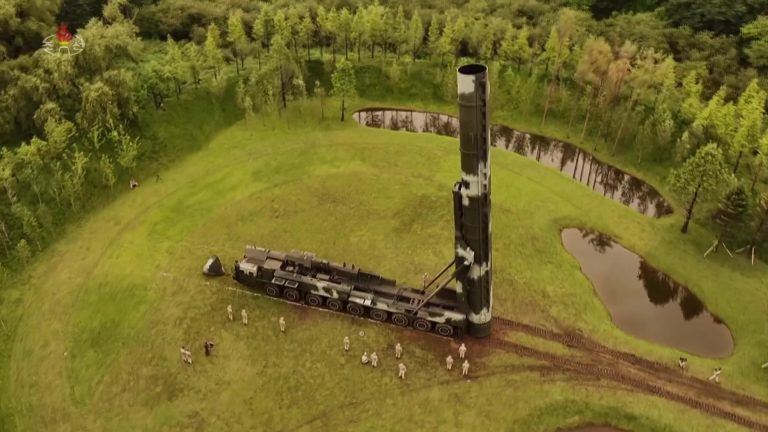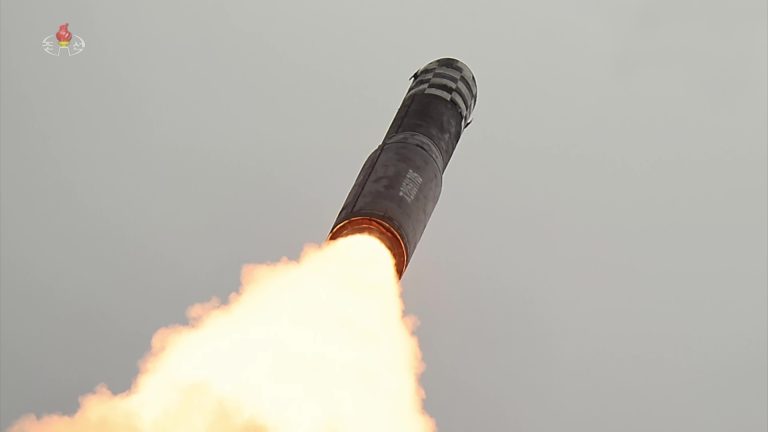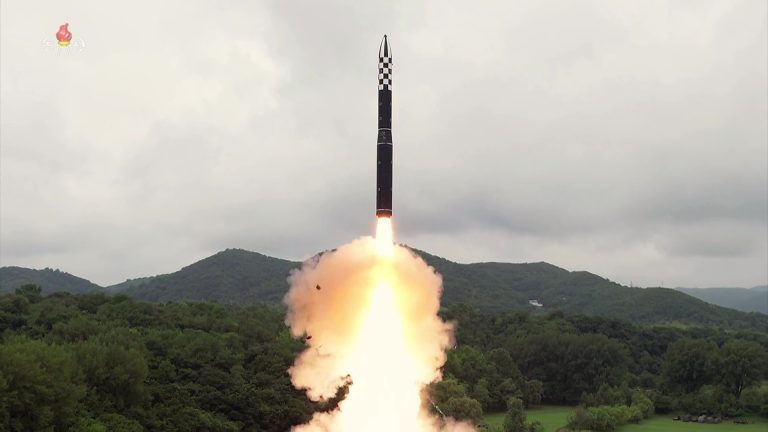Second Consecutive Flight Test Success Brings North Korea’s Hwasong-18 ICBM Closer to Deployment
North Korea successfully conducted a second flight test of the Hwasong-18 (HS-18) solid-propellant intercontinental ballistic missile (ICBM) on July 12. The road-mobile launcher and missile appear unchanged from the previous flight, also a success, on April 13. Pyongyang suggested the lofted-trajectory flight, much longer in duration and higher in apogee than that in April, demonstrated the HS-18’s maximum range capability—on the order of 15,000 kilometers (km) if flown on an operational trajectory, easily enough to reach anywhere in the continental United States.
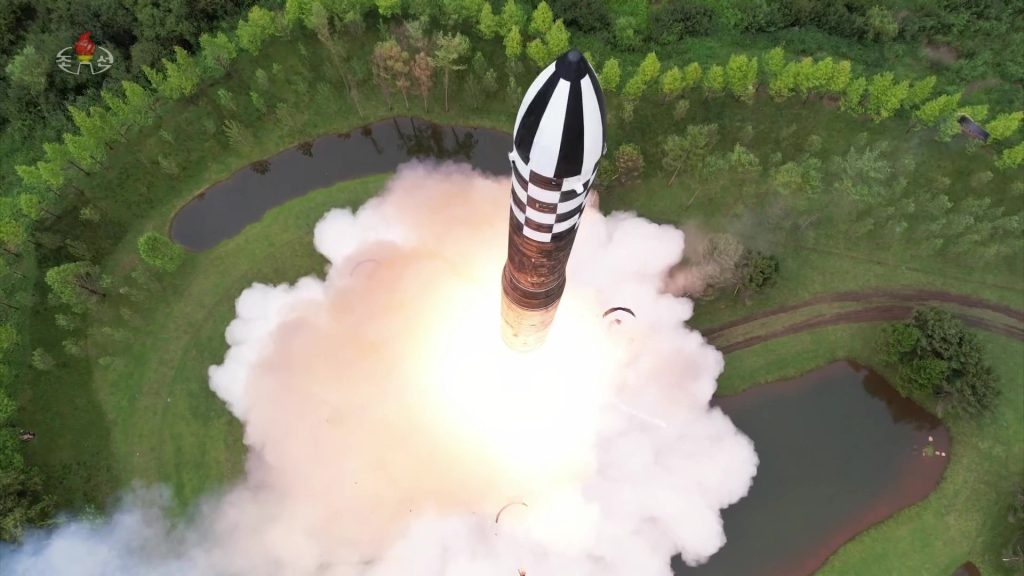
This latest achievement shows that the HS-18 is nearing operational deployment, which, given the North’s past patterns of development, could be announced soon or perhaps after one or two more tests. When it is deployed, the HS-18 will add incrementally to the existing, ongoing deployments of HS-15 and -17 liquid propellant ICBMs. Although it will be somewhat more survivable in the field than the already-survivable road-mobile liquid ICBMs, the HS-18 will not be a “game-changer” and will not substantially boost the North’s ongoing ICBM threat to the US.
Information to Date
North Korea launched an intercontinental ballistic missile (ICBM) on July 12, according to the South Korean and Japanese governments. The missile reportedly flew 74 minutes on a highly lofted trajectory with an apogee of about 6,000 km, landing in the sea about 1,000 km northeast of the launch site near Pyongyang.
The next day, North Korean media reported the successful “test-fire of new-type ICBM Hwasongpho-18” (Hwasong-18) to a range of 1,001.2 km at a maximum altitude of 6,648.4 km on a 4,491-second (74.85-minute) flight. The missile reportedly flew with “the first stage as a standard ballistic flight mode and the second and third stages as high-angle flight mode…in the maximum range system.” The launch was explained as both “an essential process aimed at further developing the strategic nuclear force of the Republic” and as “a strong practical warning to clearly show the adversaries…the unwavering will to overwhelmingly counter them…and to make the enemies clearly realize once again how risky and reckless their anti-DPRK military option is.”
Associated photos and video released by Pyongyang showed the canisterized HS-18 rolled out, erected, and cold-launched from a nine-axle, wheeled transporter-erector-launcher (TEL). The missile’s ejection from the canister, ignition and initial flight were shown, along with glimpses of stage separation.
Analysis
The TEL and missile appear unchanged from the first launch of the HS-18 on April 13—also an apparent success. The latest launch had the longest flight time and highest apogee of any North Korean ICBM flight, much longer than the previous HS-18 flight of 58 minutes to an apogee reported by Japan and South Korea to be less than 5,000 or even 3,000 km (the North did not report the apogee of that flight). The April flight was reported by North Korea to have an unusual trajectory and delayed separation and ignition of the upper stages, which probably explains its lesser performance compared to the latest flight.
Pyongyang suggested that the July launch exhibited the HS-18’s “maximum range.” According to some sources, the amount of energy demonstrated in that flight would allow the missile to travel 15,000 km on an operational “minimum energy” trajectory—easily enough to reach anywhere in the continental United States.[1] The payload weight demonstrated in both HS-18 flights is unknown; if the ultimately deployed payload is heavier than flown in the first two tests, the missile’s range will be less.
The latest launch apparently occurred from the same location as the one in April, a grass-covered concrete apron on the grounds of a private mansion near Pyongyang.[2] It has been suggested that the use of a concreted area and a wheeled TEL mean the HS-18 would be largely confined to operating on paved roads, and that consequential off-road capability would require the use of a tracked launcher. However, the fact that all of the world’s currently deployed road-mobile ICBMs—North Korea’s liquid-propellant HS-15 and -17, China’s solid-propellant DF-31 and -41, and Russia’s solid-propellant SS-25 and SS-27 Mods 1 and 2—use wheeled TELs is a strong indication such vehicles have sufficient off-road mobility to allow adequate survivability.
Implications
The second consecutive apparent flight test success of the HS-18 shows that the missile system is in the late stages of development and nearing operational deployment. North Korea may indicate soon that the missile is deployed, as it did with varying degrees of directness for the HS-15 and HS-17 ICBMs, although it may conduct one or two more flight tests first.[3]
When it is deployed, the HS-18 will add incrementally to the existing, ongoing deployments of HS-15 and -17 liquid propellant ICBMs to the extent North Korea’s production capacities for nuclear weapons and solid-propellant and its resource allocation decisions allow. The HS-18 is not “far more advanced” than the HS-15 and -17, which use modern storable propellants. It will be somewhat more survivable in the field than the already-survivable road-mobile liquid ICBMs, however, and should be at least as reliable. It continues to be the case that the addition of solid ICBMs is not a “game-changer” and “does not substantially boost the North’s ongoing ICBM threat to the US.”
- [1]
See Brad Lendon and Jessie Yeung, “North Korea says it tested an advanced solid-fueled ballistic missile. Here’s why adversaries are alarmed,” CNN, July 13, 2023, https://amp.cnn.com/cnn/2023/07/12/asia/north-korea-icbm-explainer-intl-hnk/index.html; and Song Sang-ho, “Latest N.K. ICBM test highlights steady tech pursuit, deepens surprise attack fears: analysts,” Yonhap News Agency, July 13, 2023, https://en.yna.co.kr/view/AEN20230713006200325.
- [2]
See Sam Lair. Twitter Post, July 12, 2023, 5:20 p.m., https://twitter.com/sam_lair/status/1679239446426963968; and Sam Lair. Twitter Post, July 12, 2023, 6:57 p.m., https://twitter.com/sam_lair/status/1679263778498830336.
- [3]
Interestingly, as pointed out by one sharp-eyed analyst, the Voice of Korea version of the July 13, 2023 HS-18 launch announcement included the statement that the missile “will be commissioned to the strategic force of the DPRK according to the long-term plan for building the nation’s nuclear forces.” The “commissioning” claim was not made in the Korean Central News Agency or Rodong Sinmun versions, which instead used the formulation that the “Hwasongpho-18 weapon system, equipped and operated by the strategic force of the DPRK under the long-term plan for building the state nuclear force, will [future tense] perform its mission…” It may be that for either political or programmatic reasons, Pyongyang decided to pull back for now on announcing the HS-18’s commissioning.

